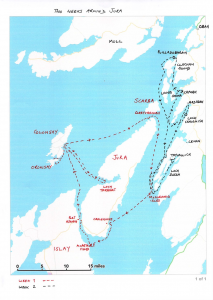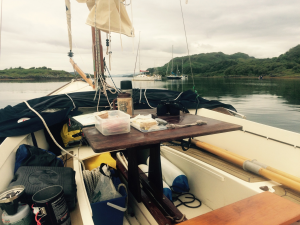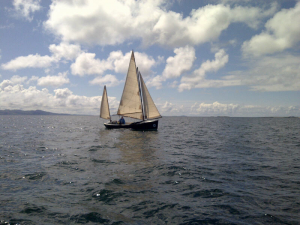Bill Rollo describes two weeks in July 2015 spent exploring the west coast of Scotland in his BayRaider 20. Click on images to view larger versions.
I had originally intended to launch Askari (a BR20) at Craobh, 20 miles South of Oban, sail South around Jura and, weather permitting, go up the Sound of Islay and out to Colonsay, taking 2-3 days to do so, spend a week or so with friends there, and then return to Craobh by what ever route seemed most suitable. In the event the weather emphatically did not permit, so, after a breezy trip North, I loaded Askari on to The Lord of the Isles at Oban and went direct to Colonsay.
The first few days were spent mostly in the lovely bays around Oronsay, where the boat was based on the small stone pier in the Strand. The boat settled happily in a pool at low tide, and more alarmingly floated just above the pier at high. On Wednesday Askari sailed in company with Puffin, a Cornish Shrimper, also single handed, on a trial run across to Loch Tarbert in Jura. We had a fine broad reach across, and then explored the 4 anchorages in the outer loch, none of which seemed particularly sheltered, admired a Wanderer drawn up high on a pebble beach with its crew camping, and turned for home as the wind seemed to be freshening. Predictably as we turned into the wind it seemed much stronger, perhaps less predictably it also seemed to gather strength dramatically with additional gusts blowing very hard down the steep glens to the south of the loch joining those funnelling in from the West. After an exciting few minutes when I thought I might be joining the Wanderer on the beach the boat behaved beautifully and clawed its way out of the loch with a single tack, while the Shrimper, unable to make progress, was eventually forced to motor. The wind then died away as swiftly as it had arisen and we sailed quietly back, leaving the exploration of the inner lochs – wild, beautiful and remote – for another day. (c20 miles).
Another 2 days of baddish weather followed, in which we planned our circumnavigation of Jura, for which we had a window of only 2 days. This ruled out our first plan of taking in the Garvellachs and using the Sound of Luing to get into the area behind Jura – the distances were just too great, and we settled on a route out via Corryvreckan, returning by the Sound of Islay. Much the most frightening aspect of the trip was the Pilot’s description of Corryvreckan, which included 4-8m standing waves and much stern advice to avoid it in all but the most benign of conditions, and then in nothing smaller than the Titanic. Fortunately we had everything on our side – very little wind, slack tide, no swell, neaps, an approach from the West, a route down the Jura shore. We left Colonsay at 0545, covered 15 miles under power in 3 hours, coming up in a gentle arc from the South to avoid the flood from Corryvreckan which extends well out to the West of Jura. We anchored for 45 minutes in Bagh Gleann nam Muc, an inlet just South of the Gulf, for coffee and to wait for slack water, and then nosed out with perhaps half a knot of tide still against us and were through in a few minutes.
Attempts to sail were thwarted by lack of wind so we continued to motor South, picking up a strong Southward stream by the light house at Ruadh Sgeir, and carrying on to the McCormaig Isles off the mouth of Loch Sween, where we anchored for lunch in the very small inlet on Eilean Mor, and compared notes with a couple of sea kayakers. Setting off again towards Craighouse we picked up a freshening breeze and had a great sail across past Skervuile Lighthouse to Craighouse at the Southern end of Jura. Craighouse itself was exposed to the Northerly wind gusting down the steep slopes beyond, and its moorings were taken, so we anchored close in by the jetty, and retired to the Jura Hotel for a very good dinner before a rather bumpy night. (c.40 miles).
By dawn things were more peaceful, but the need to catch the tide, which turned around the South end of Jura by 0830, required another early start. After a calm beginning the wind freshened from the North off McArthur’s Head, and 2 reefs later we tacked on up the Sound of Islay in bumpy conditions, finally catching the promised 2-3 knots of extra speed off Port Askaig where the Sound narrows, the wind reduced, and the water became smooth and oily, before a lovely sail back across to Colonsay. (c.25 miles).
Our weather window then closed. I said farewell to Puffin and put the boat back on to Calmac on Sunday evening to return to Oban, spending a damp night under the cover in a lay-by near Craobh. The weather then improved, and by the afternoon I was able to launch at Craobh, shoot up Clachan Sound, pass under the Bridge over the Atlantic at just the right moment – high water but still sufficient air draught – and turn left out of the top into Puilladobhrain, where I passed a peaceful night aside from the antics of a large motor sailor and its skipper who managed to drift onto the rocks a few yards away. (c. 8 miles).
Gracious Living in Puilladobhrain
My plan then was to use the good weather to cover the ground all the way back to Loch Sween and Tayvallich, before working my way gently back North up the Sound of Jura to Craobh. This sort of worked. I left Puilladobhrain early under oars, something I got into the habit of doing, and then caught the south going stream (3 knots in places) through the Sound of Luing, diverting through Easdale for fun, whistling past Fladda, and leaving the Poll Gorm and ‘Back o’the Pond’ anchorages by Cullipool for another day. A long day of motoring and light rain followed. I anchored behind Carsaig Island for an hour to brew up and warm up, and later in the afternoon took to the oars to conserve fuel before being able to sail again up Loch Sween, which became increasingly pretty after the hideous caravan park at its beginning. Tayvallich itself was perfectly sheltered but somehow a little ordered, so I left after a short halt and moved around the corner to the even more sheltered Fairy Isles where I spent the night in the company of a single French yacht. (c.40 miles).
Another early-ish start took me back down Loch Sween – 7 or so miles – before turning back to the North, another lunchtime anchorage in Achanarnich Bay and a good sail up past Crinan and into Loch Craignish and Ardfern. After a brief supply stop at Ardfern, and an unsuccessful attempt to stop in the Pilot’s recommended spot, behind an islet (Eilean nan Gabhar) which looked fine but was subject to gusts and swell, I anchored quietly half a mile away in a few feet of water inside a reef, leaving early again under oars the following morning to avoid being caught there as the tide fell. (c.28 miles).
A lovely sail took me down to catch the tide North at the Dorus Mor – very satisfying to arrive just as the tide turned and see a yacht coming the other way stop midway through the channel as we tacked through with the tide already bubbling and swirling underneath us. A great afternoon in perfect conditions back up to Shuna and Craobh followed – it was hard to stop. (c12 miles).
Thoughts for another time:
Unless you are lucky and have settled weather with a High over Scotland and Easterlies the weather will come and go. It’s important not to feel pressurized over time so that you can choose when to sail and when to stop.
While it is possible to cover big distances – upto 40 miles in a day – under motor in calm conditions or with a steady breeze, this is not perhaps the best way of enjoying an intricate and fascinating coastline. Better to have time to explore and to be able to nose into the nooks and crannies. Perhaps best to use the tide and plan for not more than 6 hours (say 20 – 25 miles) and then explore.
Navigation required concentration, and a particular focus on catching the critical tidal gates, but was very satisfying when it worked. Much of this could be done in advance, sparing the need to spend too much time on it in the evening, or to carry too much material vulnerable to damp.
Imray Charts C64 and C65, together with the 2014 Imray/CCC Pilot, and the Garmin 450 for detail, worked well. The very detailed Antares electronic charts might have been useful from time to time but I have not cracked the best way of using them (they do not work on my elderly Garmin, and for a variety of reasons – not least the dynamics of trying to use a further device while entering an anchorage – I did not get round to downloading them on either a phone or tablet).
The Pilot’s recommended anchorages are fine so far as they go, although not foolproof. However, they are understandably based on the requirements of a 30 – 40’ keelboat. Almost invariably a shoal draft boat can find a space further into the anchorage, or another more sheltered area inside the skerries.
The BR 20 is very capable. I did not feel anxious about the boat at any stage, although admittedly I was pretty cautious about the weather. I always used water ballast and frequently a single reef, with which the boat sailed happily in a wide range of conditions.. The boat motored and rowed well, at 5 and 11/2 knots respectively.
Midges were not an issue on the water. Camping on the boat was fine, with or without the tent, which I tended not to use if I thought I might have to move or tend the anchor in a hurry. There is masses of space for one, and ample stowage for food and water for several days. I used both a conventional flat gas cooker and a Jetboil.
Fuel for the outboard needs to be thought about – the days of village pumps on the waterfront are gone – but equally the Mariner 4hp four stroke at 5 knots is pretty frugal. It would be sensible to carry a spare 5litre can and to be aware of where fuel is available.
Aside from fuel my main logistic concern was battery life. My 2 20W solar panels kept the little 7AH battery, and therefore my plotter, charged up well in good sunlight, but long days of damp put the system under pressure and required rationing of plotter use. Next year I will try a bigger battery.
I would like a more reliable method of getting a weather forecast. Windguru was excellent when I could get a suitable signal, but I found the CG forecast on VHF difficult to hear and tended to miss it when sailing.
A tender of some kind would be tempting, but is probably not necessary, particularly if one is prepared to buoy an anchor – not a hazard to others in very shallow water.
I used the supplied Breton 6kg anchor with 5m of chain and 25m of line available without incident. While there might be moments when something bigger might be comforting it was possible on this trip to find shallow and sheltered water with reasonable holding.
In the area covered places to go to would include Oronsay, inner Loch Tarbert, the Ardmore Islands on the South East Coast of Islay (a couple of miles East of Ardbeg, Lagavulin and Laphroig), the MacCormaig Isles and the upper reaches of Lochs Sween and Craignish. North of Craobh: Shuna and Loch Melfort, Ardinamir, Clachan Pool, the Garvellachs and Black Isles, and the inner anchorages around Cullipool, would all be worth exploring in the right conditions, although the latter 3 are more exposed. Gigha is within reach of Loch Sween.
Bill Rollo.




Hi Bill, Sounds a lovely trip. Easdale is fun, isn’t it!
Bill,
Very inspiring trip account. We had planned on being up that way to visit friends on Muck before the Caledonia Rally but the rally was cancelled so we have shelved it for next year. I had hoped to do a circumnavigation of Mull but your itinerary also looks great. Devon and Cornwall this year.
Regards,
Mark “Pippin”